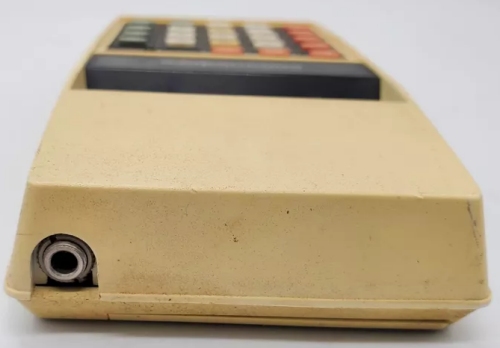
The Commodore 887D calculator, introduced in 1975, is a robust and functional calculator that reflects the technological advancements of its time. Manufactured by Commodore in the USA, this calculator is known for its reliable performance and user-friendly design.
Physical Characteristics
The Commodore 887D measures approximately 75mm in width, 144mm in height, and 24mm in depth at its maximum point. Weighing 108 grams without batteries, it is compact and portable. The calculator is powered by a 9V DC battery (PP3 size) and also accepts an adaptor (505 or DC-620R with a 3mm plug, center positive) through a socket located on the top side. It is important to remove the battery before using the adaptor to avoid any potential issues.

Case and Display
The calculator features a two-piece matte plastic case in dark brown and beige. The keyboard surround is in matching dark brown, while the panel below the display is glossy black with a silver printed logo. The keys are small and squishy but responsive, adhering to Commodore’s typical key color scheme. The red plastic flat filter over the display is heavily inset, forming a light screen that enhances visibility. The display itself is an 8-digit red LED with a bubble lens, featuring a ninth digit for negative, memory, and error indication.

Features and Components
The Commodore 887D offers standard four functions, percentages, register exchange, and a four-function memory. It is equipped with a Commodore GRBP-89 7527 CPU, an ITT 548-5N 7522 IC, a 9-digit single unit bubble lens LED display, and one resistor. The main CPU board (PCB 200570 Rev A TO-ITT) rests above the keyboard assembly (KB-6373-01) and is connected through a 14-way ribbon cable. The keyboard assembly is held in place by four plastic lugs at the front.

Disassembly
To disassemble the calculator, remove the two screws from the back of the case. Gently push the two lugs in the lower section cutouts and squeeze off the back. There are two inner lugs that can be seen from within the battery compartment.
Below is the main circuit board. The main board has the CPU, display driver and display and one resistor. For its age this was quite advanced. The board really didn’t need to be this long, it just made mounting easier. You can just see the ribbon cable at the bottom that connects to the keyboard assembly.

Logic Comments
- (C) is used once to cancel the last number entered and a second time to clear the whole calculator.
- There is automatic constant on all four functions.
- Input overflow is suppressed; inputting a ninth digit is ignored.
- Negative numbers are shown with a “-” in the immediate left-hand digit, traveling into the far left (ninth) to allow eight-digit negative numbers.
- The (MR) key recalls the memory, and the (MT) key recalls and clears the memory.
- Memory store is indicated by the far left (ninth) digit’s decimal point.
- It is possible to store an overflow in the memory and later recover it by continual division by 10.
- Divide by zero shows “E00000000” (no decimal point) and is recoverable by dividing by one.
- Overflow shows the result with “E” (negative or positive) in the leftmost (ninth) digit and is recoverable by continual division by 10 (or a multiple).
- (EX) is used to exchange the display with the register.
- The (%) button divides by 100 and can also be used to recover from overflows.

Summary
The Commodore 887D calculator is a well-designed and functional device that offers a range of features suitable for its time. Its robust logic, flexible memory, and clear display make it a reliable tool for various calculations. The 887D is a great example of Commodore’s innovative approach to consumer electronics in the 1970s.


